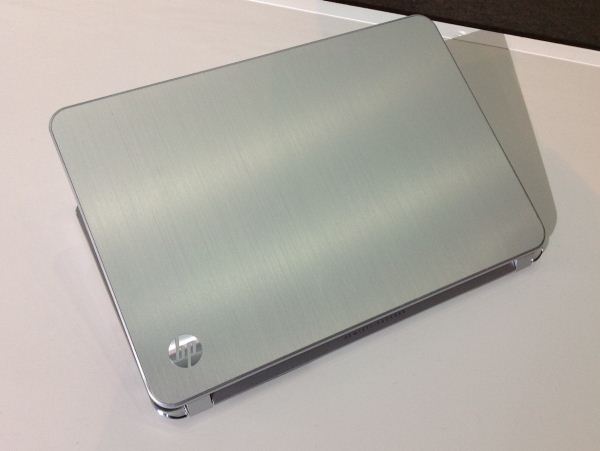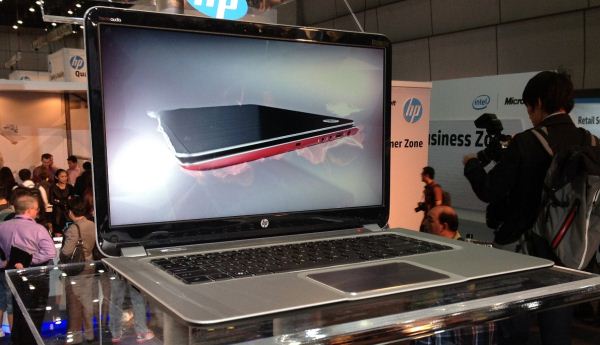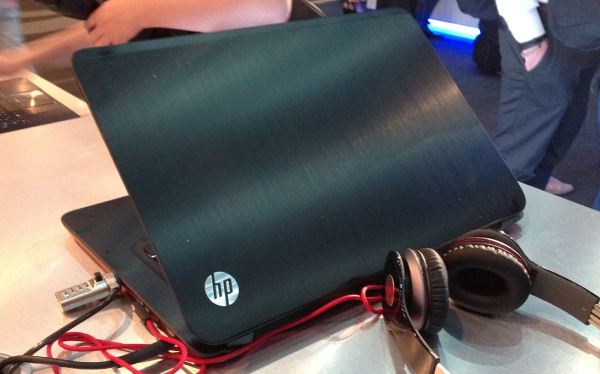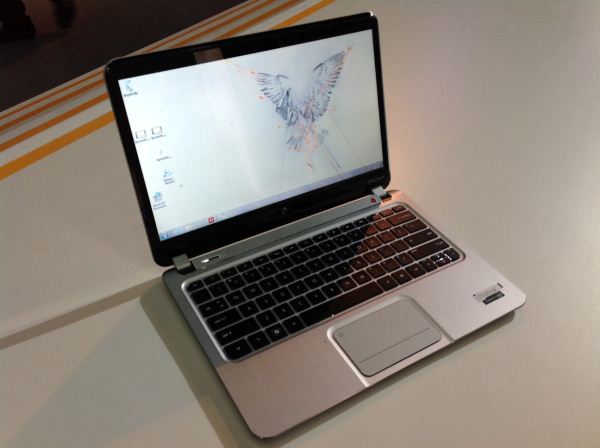HP Unveils New Ultrabooks, "Sleekbooks"
by Vivek Gowri on May 10, 2012 1:13 AM ESTAt the 2012 Global Influencer Summit in Shanghai, HP announced a full slate of new thin-and-light and ultrabook systems, and we've gotten to go hands on with all of them.
The most important products of the lot are the new Envy ultrabooks and sleekbooks. Sleekbook is just a marketing term to describe notebooks that don't meet all of Intel's criteria for ultrabook classification due to CPU and storage component selection, but are otherwise identical to the ultrabook line, including sharing the same 19.8mm thick chassis.
Both of the model lines are available in 14" and 15.6" sizes, and feature Beats audio, glass trackpads with multitouch and gesture support, and optional backlit keyboards. The lid and palmrest are brushed aluminum, while the bottom of the notebook is a soft-touch plastic material. There are two color options - silver metal/black plastic, or a much more visually arresting black metal/red plastic model. The ultrabook lines are based on Intel's 3rd generation Core ultra-low voltage processors, similar to other ultrabooks, while the sleekbooks come with normal Ivy Bridge processors in the 14" or AMD"s Fusion APUs in the 15.6". The entire lineup has battery life quoted in the 8-9 hour range (depending on screen size and CPU choice). I suspect that the ultrabook and sleekbook versions of the will be mixed up very often (I saw some HP product managers confuse the different demo units more than once here in Shanghai), but what gets lost is that effectively, they're all just different flavors of the same notebook.
HP has always chosen to design its volume platforms as highly modular systems, with consumers and retailers able to chose from a variety of screen sizes, Intel or AMD processors, and a variety of storage/memory/graphics options. For the first time, we're seeing that mentality hit the ultrabook-class of device. HP has designed the new Envy as a single platform with two screen sizes, a range of Intel and AMD processors, a choice of mechanical, solid-state, or hybrid storage options, and optional AMD dedicated graphics (for the Intel models - the AMD models have onboard graphics that are deemed good enough to not merit a dGPU option). If you tick the right combination of boxes (Intel ULV CPUs and hybrid or solid-state storage), the Envy can meet Intel's spec to be classified as an ultrabook. If not, HP calls it a sleekbook. It's a bit confusing, especially in HP's relatively vague press blast, but upon explanation, the new term makes sense.
The Envy devices are pretty nice, with an attractive design (particularly the red and black one) and solid build quality. THe interesting thing here is that the AMD-based Envy 6 (the 15.6" Envy) starts at $599, making it a pretty great value for that price point considering the premium design and features. The base Envy 4 starts at $699, while the ultrabook-spec Envy 4 (essentially the same system, except with a 32GB mSATA caching drive to suplement the mechanical storage) goes for $749. The Intel-based Envy 6 starts at $799 and comes standard with the caching drive, thus meeting the ultrabook spec as well. The AMD-based Envy 6 will be available on June 20, while the rest of the Envy systems are available now.
HP is also expanding the premium Envy Spectre line with the Envy Spectre XT. Unlike the Spectre 14, the Spectre XT has a 13.3" display and is made entirely of anodized brushed aluminum. The very attractive all-metal design goes in a different direction than the Spectre 14, which was the first notebook to be made primarily of glass. While innovative, the Gorilla Glass chassis led to the Spectre 14 being a bit expensive, as well as thicker and heavier than most ultrabooks tended to be. The Spectre XT, on the other hand, has much more petite dimensions and measures 14.5mm thick at the thinnest point, along with a 3.07lb weight (1.395kg). The Spectre XT certainly feels like a step up in design and build from the Envy, but it's not as unique or as immediately stunning as the Spectre 14. The Spectre XT will hit market on June 8th, with a starting price of $999 with Intel's Ivy Bridge ULV processors and solid state storage. The Spectre XT is aimed squarely at the Samsung Series 9 ($1399) and other premium ultrabooks, so HP seems to be pricing their new portables relatively aggresively. It's a good sign, one that means we'll likely see the entire ultrabook market go more mainstream in terms of price point going forward.
In other ultrabook news, HP announced their first ultrabook meant specifically for the corporate world - the EliteBook Folio 9470m. The 9470m has a 14" screen and weighs a scant 3.6lbs. It squeezes a number of enterprise-centric ports and features into its 19mm thick frame, including VGA, DisplayPort, a full-sized Ethernet port, Smart card reader, fingerprint scanner, embedded TPM security chip, and Intel's vPro security technology. It will come with Ivy Bridge mobile processors and an optional SSD, and is expected to be available sometime in October 2012.















23 Comments
View All Comments
BSMonitor - Thursday, May 10, 2012 - link
No, it is not. The AMD 15" is only 1366x768, same as the 14" ultrabook. As expected, AMD's claim of cheaper ultrabooks comes at the expensive of quality components.. Not the difference in APU price.No one wants an "ultrabook" with an HDD. Kinda kills the "instant on" theory.
ananduser - Thursday, May 10, 2012 - link
The AMD 15" and 14" are ultrabook class notebooks. It has that resolution because it is a cheap device; cheap as in inexpensive and not necessarily low quality. You want 1600x900 for a 600$ ultrabook ? It isn't possible.I think there is an AMD model sporting a SSD HDD combo.
And lastly that's why they are called sleekbooks; they aren't supposed to be ultrabooks to the letter so there is no instan-on requirement. Regardless W8 will make them pretty snappy even sans SSD.
kyuu - Friday, May 11, 2012 - link
These aren't ultrabooks, and aren't beholden to ultrabook specifications like the "instant-on" thing, so I'm not sure where your "kills the 'instant on' theory" comment comes from. How in the hell do you expect to fit a decent-sized SSD into the budget of a $500 laptop, anyway?The problem with HP's lineup, as far as I'm concerned, is that they're only sticking AMD's APUs into the 15.6" models. If I want a 14" model but want an AMD APU, I'm out of luck. Why? What's the reasoning for this decision?
Although, if there's no option to upgrade from the low resolution, glossy, poor-quality screens, I wouldn't touch these with a 10 foot pole anyway.
ananduser - Friday, May 11, 2012 - link
Because they are ultrabook in chassis, aka light. That's their reasoning. Ultrabook-like notebooks at lower price points. That's Trinity's purpose. And between 13" x768 and 15" x768; 15" is a little bit better.kyuu - Friday, May 11, 2012 - link
Right, ultrabook-like notebooks in terms of form factor at lower price points. I don't recall seeing AMD claim anywhere that you'd get SSDs in them, although I'm sure you will be able to get SSDs if you want to pay for it.While many here might not be willing to go for an ultrabook without an SSD in it, I can guarantee you that, among the general population, most still probably don't even know what an SSD is, let alone care about whether or not their ultrabook (or ultrathin) has one. Myself, I'd be fine if I could get one with a Momentus XT hybrid drive.
I'm not sure how you come to the conclusion that x768 is better at 15" than 13" (or 14", which is what I was talking about). The larger the display, the worse that resolution will look. And resolution isn't the only issue -- x768 panels are invariably cheap junk all around. And I don't want a laptop of any form factor over 14", as I find that the best balance of portability vs. usability.
ComputerGuy2006 - Thursday, May 10, 2012 - link
why did I get this spam in my RSS feed thats supposed to contain only reviews?andrebrait - Thursday, May 10, 2012 - link
Then I'll pass...Sincerely, I've had three HP notebooks...
A first-gen Core 2 Duo with a GeForce 7600GS
A AMD A8 APU with a dedicated HD6770M
A DM1-series AMD E-350 APU.
The first one died and was replaced. The replacement died after the warranty was over. They both died for unknown causes, I'm very, VERY careful with my notebooks.
The A8 started displaying video corruption. I returned it.
The DM1 would get slow for no cause, the WLAN only connected with 65mbps (1 antenna, 20Mhz-only channels, no 40MHz channel support lke any other decent solution) and the Wired LAN would never get to its supposed to be supported 1Gbps. Max throughput was 550Mbps.
I'm done with HP. Also, I have three friends whom HP notebooks died suddenly and before that the screen was displaying every sort of stuff. They were all clean and well cooled.
My CCE (a Brazilian cheap electronics manufacturer) 2nd-gen i3 is still Alive. My Clevo barebone is alive and strong. My mother's Acer 1410-series is well and working very well for something that's threw in her bag every morning to go to work. God, my Idon'tknowhowmany years old Pentium M is alive. HP never again.
mikael.skytter - Thursday, May 10, 2012 - link
Same for me.With 3 HP notebooks. The 3:d that I am on now have accually managed to last.
The first one died from the famous Nvidia hardware problem.
2:nd as well
Flunk - Thursday, May 10, 2012 - link
I had a similar experience with an AMD based dv2000. It mysteriously died shortly after the extended warranty after being carefully looked after. I happen to have a working 486 ThinkPad that has to be about 20 years old. I don't necessarily expect that but 5 years would be nice.jabber - Thursday, May 10, 2012 - link
.....simply refuse to review such kit when the corps ask you to?Simply say "Sorry but our readership wouldn't buy kit with such inferior screen specifications!"
Maybe then they will get the message.
It seems that bleating on about it in review after review of crappy screened kit isn't getting through.